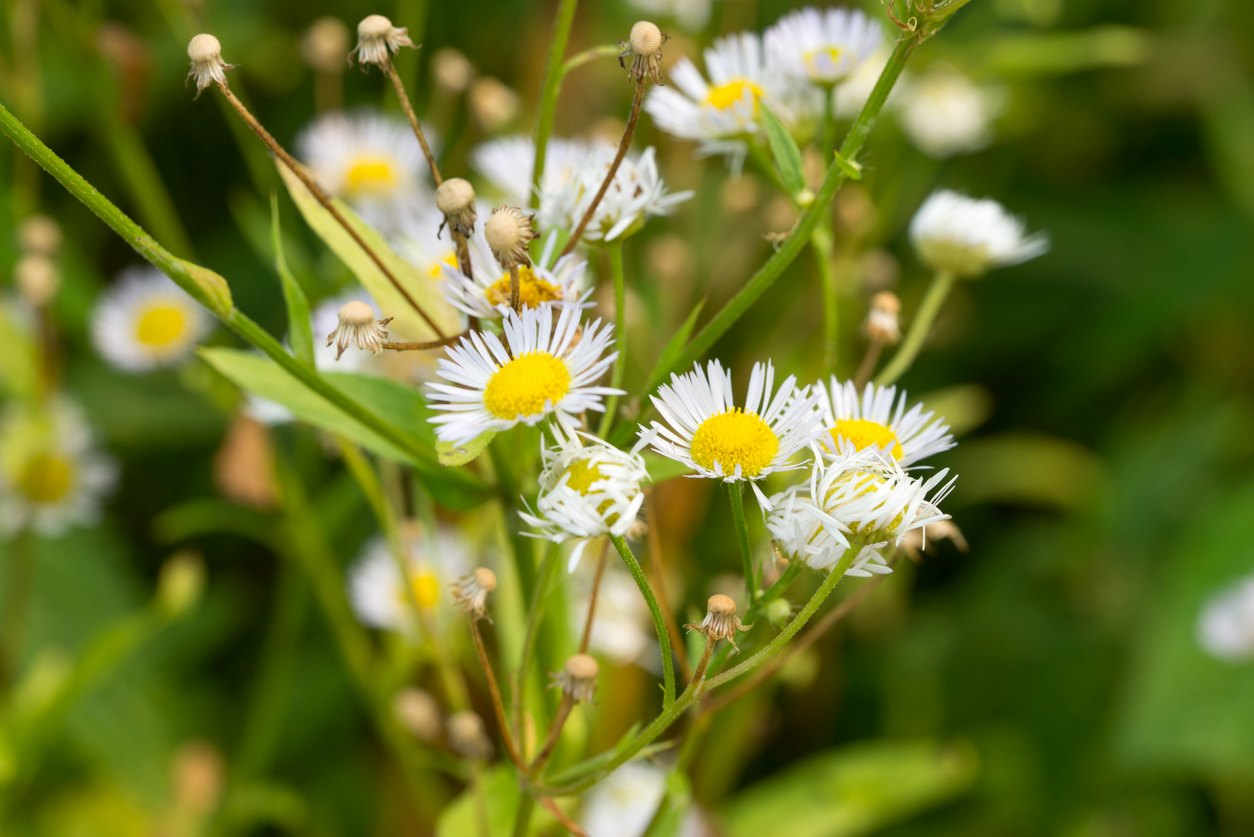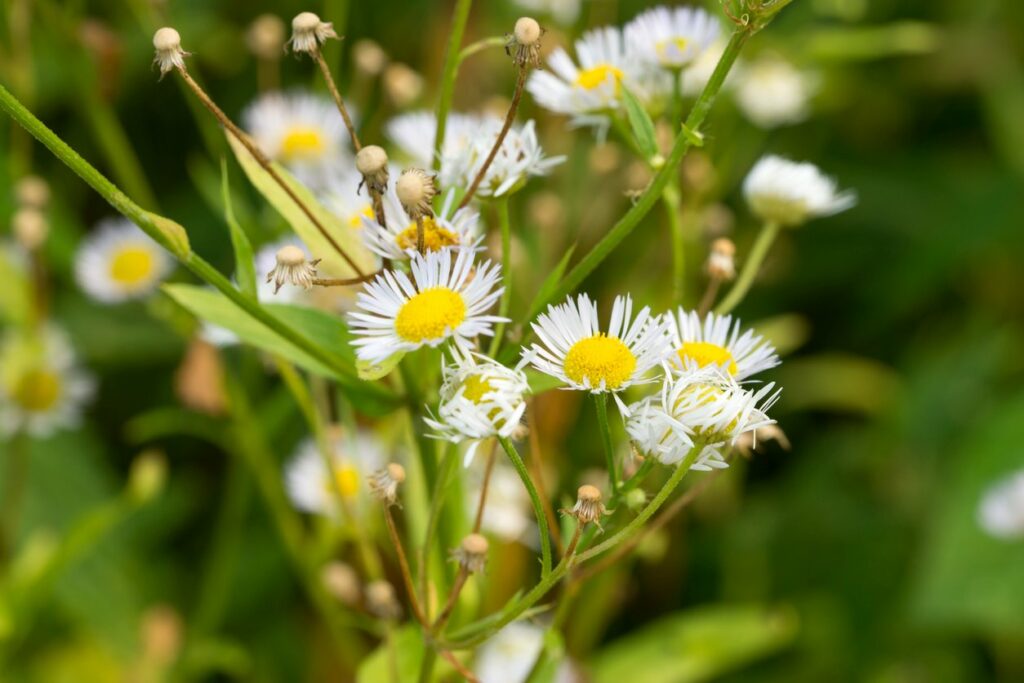Daisy Fleabane Growing: How To Care For Fleabane In Garden
The daisy fleabane is a quaint plant with delicate flowers that will make you stop in your tracks to admire them. So if you have an empty spot that you just don’t know what to fill it with, the daisy fleabane got you covered. Or if you have a corner in the shade of a shrub or a tree that doesn’t fit in your landscaping designs. Why not grow the daisy fleabane there and turn it into a bright and cheerful corner?
These small plants fit in just about anywhere. You can grow them along a path and when they bloom, your edging path becomes a sea of swaying flowers between the late spring and fall. And best of all, they are easy to grow and even auto-propagate which in a way would make your gardening a whole lot easier. All you need to do to keep it blooming throughout the fall is to deadhead and pick off the fading flowers. It doesn’t get easier than that.
Daisy Fleabane Facts
Daisy Fleabane plants (Erigeron annuus) are annuals with an interesting feature. Their flowers bloom in the early spring then turn into fuzzy white balls of seeds even while other flowers are still growing and blooming. This gave it the name Erigeron which is Greek for ‘early’ and ‘elderly person’ at the same time.
The name fleabane is associated with an urban legend that if you burned the dried stalks of these daisies, they would keep your home free of fleas and other bedbugs. That’s a myth of course and fleas were never repelled by daisy fleabane at any time in history.
That said, there are redeeming qualities to the daisy fleabane even if it has no practical benefits against bed bugs. For one thing, their composite flowers are real show stoppers. While they look similar to the aster family, these daisies bloom early in the spring and stay in bloom until the fall. Out of the central disk in the middle long and slender petals radiate in geometrical symmetry. They are usually either white or pale pink.
The leaves are hairy and have a green-gray color. They are edible and you can use them in cooking to add flavor to your greens. The plant itself varies in height between 12 inches to 5 feet high depending on the variety and conditions.
Daisy Fleabane Varieties
While they grow in the wild in just about every pasture or open space you can think of, you should consider cultivars not natural species for your garden. The cultivars are often more disease resistant and have brighter and longer-lasting blooms than the natural species of the daisy fleabane. Here are some of the varieties to grow in your garden.
- Wayne Roderick: This cultivar actually is an evergreen perennial, unlike the natural species which are annuals. It grows into a clump that reaches about 24 inches wide and 12 inches high. The flowers are often lavender in color and bloom throughout the summer and fall. Many pollinators such as bees flock to a garden where these daisies bloom. It tolerates clay as well as saltwater better than other varieties.
- Sea Breeze: Another evergreen perennial that grows to about 10 inches high. It also forms a clump and spreads to about 2 feet wide. The leaves are often green-gray and the dainty flowers are either pink or lavender.
- Pink Santa Barbara Daisy: As colorful as the name is, it aptly describes every bit of this exquisite flowering daisy. It grows to about 18 inches high although the clump doesn’t spread out as other varieties on the list. It reaches about 36 inches in width at most. The flowers are often pinkish and larger and a little brighter. However, unlike other varieties, this one doesn’t reseed.
- Santa Barbara Daisy: A fast-growing evergreen perennial that blooms lavishly throughout the summer and fall. The flowers are often white or pink with a golden disk in the center. It grows naturally out of any crack in the pavement or sidewalk. It auto reseeds and spreads out like a blanket of flowers.
How to Grow Daisy Fleabane
As you can see, some of the daisy fleabane varieties are hardy plants that can tolerate the harsh conditions of the wild. That should indicate that they are easy to grow. The fact that the plants reseed themselves and grow out of any crevice just proves how hardy they are. When you grow them in your garden, make sure they get protection from the afternoon sun. Here’s how to grow daisy fleabane plants in your garden in easy steps.
- Before you plant your seeds, choose a spot that doesn’t get direct sunlight during the noon or afternoon hours.
- The easiest way to grow the plant is by division. So choose a healthy plant growing in the wild and dig it up.
- Use a spade to dig a wide circle around the root system of the plant then take it out.
- Examine the roots to make sure they are healthy then divide the plant into 4 sections.
- Make sure the roots are covered with enough soil to keep them from drying out.
- Dig a hole in the ground for each section you want to plant. Make the hole as deep as the length of the rootball of the plant.
- Place the plant in the hole and make sure the top of the rootball is under the edge of the hole.
- Refill the hole with soil and pack it to push out any air pockets.
- Drive a stake next to the daisy plant and tie them together. Keep the knot loose. This stake will stay in the ground until the plant establishes.
- Water the soil to help the roots settle.
- Keep the soil moist but not wet until the roots establish.
- Untie the stake and remove it from the ground.
Daisy Fleabane Care
That’s as easy as it gets when it comes to growing a flowering plant. Of course, you could grow the daisy fleabane from seeds but it’s often easier to just divide a healthy plant and grow it in your garden. We mentioned that these are hardy plants that tolerate all types of soil and weather conditions. They can even put up with saltwater and not let it dampen their spirits.
Light
The only thing that could put a dent in your frolicking daisy fleabanes is too much sunlight. Yes, there’s such a thing as too much sun. While they can handle the sun, the excessive intensity of the noon sun can impact the blooms in a way not to your liking. So always make sure that the spot gets the morning sun but as the day progresses, partial shade protects the daisies from the noon and afternoon sun. It helps to observe your garden beforehand and pick a spot that is ideal for the sun-shy daisies. Keep in mind that intense sun might decrease the number of blooms you get out of your daisies.
Soil
The best type of soil for the daisy fleabane plants is well-drained and loamy soil. That said, these hardy plants will happily grow in clay and heavy soil as well. But you don’t want to take the chance. Not when you grow the daisies for their lovely blooms and flavor-packed leaves. Mix your clay soil with some sand or perlite and add in a generous portion of mushroom compost to keep the daisies well fed throughout the bloom season.
Watering
You won’t have to worry too much about irrigating the daisy fleabane once its roots are established. Usually after planting it, you’ll need to water it regularly just enough to keep the soil moist. But as they grow new leaves you will know that the roots took to the soil. The plant is drought resistant and doesn’t like to get its feet wet. Make sure to water it once a week during the hot summer months but hold off the water when the temperature drops. Once every two weeks will be fine.
Pruning
For a plant that forms clumps and has a propensity for auto reseeding, the daisy fleabane can be a headache for the novice gardener. You will need to take your pruning shears to the plant often to keep it in shape. Apart from that, always pluck out fading flowers to encourage the plant to keep growing more flowers. That way you can have blooming flowers from the early spring all the way to the fall. The plant tends to get leggy after a while. So once the last flowers have faded, cut back the plant heavily to keep it compact. Experts recommend you cut back up to one half of the plant every year.
Pests and Diseases
It goes without saying that the bright blooms of the daisy fleabane attract all sorts of good bugs and pollinators. But in the process, they also draw in the wrong crowd of bugs and pests. From aphids to whiteflies and spider mites, you got your hands full. While you can always hose them away with water, this could backfire if you have high humidity and could lead to fungal infestations. So either you pick them up by hand and drown them in a bucket. Or you can use neem oil to get rid of large infestations.
The main health problem you will have with these daisies is yellowing leaves. This is a common problem that too much sunlight causes. The leaves usually turn yellow and drop in mass when the plant is not in a shaded area. Yellow leaves could also be a symptom of the plant not getting enough water. Water the daisies regularly in the summer to keep them growing and blooming.

